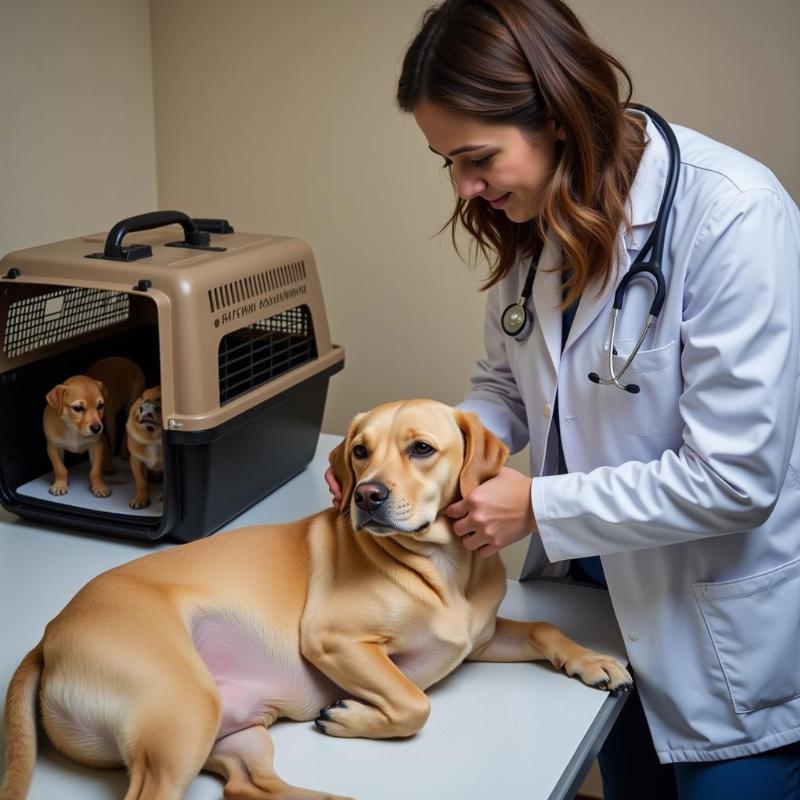Spaying your dog after she’s had puppies is a responsible choice that helps control pet overpopulation. However, determining the right timing requires careful consideration. This crucial decision impacts her health and recovery, so understanding “how soon can you spay a dog after having puppies” is essential for every responsible pet owner in the US. We’ll explore the factors influencing this decision, recommended waiting periods, and potential risks associated with spaying too early or too late.
The ideal time to spay a dog after giving birth is a topic often discussed among veterinarians and breeders. While there’s no one-size-fits-all answer, several factors play a key role. These include the dog’s overall health, breed size, litter size, and any complications during pregnancy or delivery. Understanding these factors can help you and your vet determine the best course of action.
Factors Influencing Spaying Time
Several factors influence when a dog can be spayed after giving birth. Her health is paramount. A dog experiencing post-partum complications, such as mastitis or metritis, requires complete recovery before undergoing surgery. Breed size also matters. Smaller breeds generally recover faster than larger breeds. Litter size plays a role as well, as nursing a larger litter can take a greater toll on a mother dog’s body.
Health Considerations
A healthy dog is better equipped to handle surgery and recover smoothly. Ensure your dog is free from any infections or illnesses before scheduling the procedure.
Breed and Size
Smaller breeds often bounce back quicker, allowing for spaying sooner. Larger breeds may require a longer waiting period for their bodies to fully recuperate.
Litter Size
Nursing a large litter can deplete a mother dog’s resources. Allowing sufficient time for her to regain strength is crucial before considering spaying.
Recommended Waiting Periods
While consulting your veterinarian is crucial, a general guideline suggests waiting at least 6-8 weeks after the puppies are weaned. This allows the mother dog’s body to return to its normal physiological state. Waiting also reduces the risk of complications during and after surgery.
Traditional Recommendations
Traditionally, vets often recommend waiting 6-8 weeks post-weaning. This timeframe allows for hormonal stabilization and uterine involution.
Modern Veterinary Approaches
Some modern vets are open to spaying earlier, especially in shelters and rescue situations to prevent further unwanted litters. This requires careful evaluation and monitoring.
Potential Risks of Spaying Too Early or Too Late
Spaying too early can increase the risk of complications such as bleeding and infection due to the uterus not being fully healed. Delaying spaying too long, however, can increase the risk of mammary cancer and unwanted pregnancies.
Risks of Early Spaying
Early spaying can compromise healing and increase susceptibility to infections.
Risks of Delayed Spaying
Delaying can elevate the risk of mammary tumors and unwanted pregnancies, especially in dogs allowed to roam freely.
When Can a Female Dog Be Spayed After Having Puppies? – Addressing Specific Concerns
Addressing the question of “when can a female dog be spayed after having puppies?” directly requires a personalized approach. Consulting with your veterinarian is paramount. They will consider your dog’s individual health, breed, litter size, and any potential complications to recommend the optimal timing for spaying.
“In my experience, the best approach is to discuss spaying with your vet soon after the puppies are born,” says Dr. Emily Carter, DVM, from the Animal Care Clinic of Austin. “This allows for a proactive plan and addresses any potential health concerns early on.”
 Veterinarian examining a dog after she has given birth
Veterinarian examining a dog after she has given birth
Conclusion
Spaying your dog after she’s had puppies is a responsible decision. Understanding the factors influencing the timing, recommended waiting periods, and potential risks of spaying too early or too late helps you make an informed choice. Consult with your vet to create a personalized spaying plan for your dog’s specific needs. By working closely with your veterinarian, you can ensure a safe and successful spaying procedure for your dog, contributing to her long-term health and well-being.
FAQ
- How long should I wait to spay my dog after she has puppies? Generally, 6-8 weeks after weaning is recommended, but consult your vet for personalized advice.
- What are the risks of spaying too early? Early spaying can increase the risk of complications like bleeding and infection.
- What are the risks of spaying too late? Delayed spaying can increase the risk of mammary tumors and unwanted pregnancies.
- Why is it important to spay my dog? Spaying helps control pet overpopulation and reduces the risk of certain health issues.
- How can I determine the best time to spay my dog? Consult with your veterinarian for a personalized recommendation based on your dog’s individual circumstances.
- Can my dog be spayed while she’s still nursing? It’s generally not recommended to spay while nursing. Weaning the puppies first is usually advised.
- Will spaying change my dog’s personality? Spaying does not typically alter a dog’s personality, though it can reduce certain hormone-driven behaviors like roaming.
Related Articles
Beautdogs.us is your premier resource for comprehensive dog care information, breed insights, and expert advice. Whether you’re a seasoned dog owner or just starting your journey, Beautdogs.us offers valuable, up-to-date resources to support your dog’s well-being. We cover various topics, from puppy care to senior dog health, ensuring you have the knowledge to provide the best possible care. Connect with us for personalized guidance and support. Email: [email protected], Phone: +1 501-555-7529. Visit Beautdogs.us today!